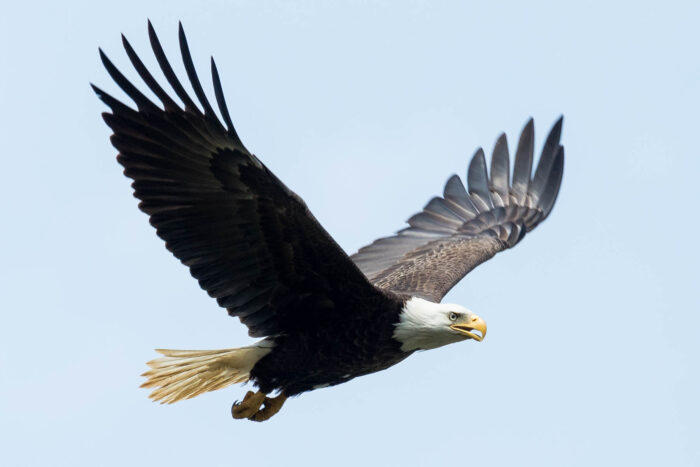Eagles: Majestic Raptors of the Sky
 Eagles, with their formidable wingspan, keen eyesight, and powerful talons, have long captivated the human imagination. These majestic raptors, belonging to the family Accipitridae, are known for their prowess in flight and their symbolic significance across cultures worldwide. In this exploration, we delve into the remarkable world of eagles, examining their biology, behavior, ecological roles, and cultural significance.
Eagles, with their formidable wingspan, keen eyesight, and powerful talons, have long captivated the human imagination. These majestic raptors, belonging to the family Accipitridae, are known for their prowess in flight and their symbolic significance across cultures worldwide. In this exploration, we delve into the remarkable world of eagles, examining their biology, behavior, ecological roles, and cultural significance.
Biology and Characteristics
Eagles are large birds of prey characterized by their robust build, hooked beaks, and keen eyesight. They belong to the genus Aquila and are distributed across various habitats worldwide, from mountains and forests to grasslands and wetlands. While their appearance may vary depending on the species and geographical region, eagles generally exhibit similar physical traits optimized for hunting and survival in their respective environments.
One of the most striking features of eagles is their impressive wingspan, which enables them to soar high above the landscape in search of prey. Depending on the species, wingspans can range from approximately 1.8 meters (6 feet) in smaller eagles like the African hawk-eagle to over 2.5 meters (8 feet) in larger species such as the Steller's sea eagle. This wingspan, coupled with strong, broad wings and specialized feathers for gliding, allows eagles to effortlessly navigate the skies and cover vast distances during flight.
Eagles possess exceptional vision, with eyesight several times more acute than that of humans. This heightened visual acuity enables them to spot prey from great distances while soaring at high altitudes. Their eyes are equipped with a high density of cone cells, allowing for enhanced color perception and the ability to discern fine details even in low light conditions.
Another notable characteristic of eagles is their powerful talons, which serve as formidable weapons for capturing and immobilizing prey. These sharp, curved claws are adapted for gripping and tearing, allowing eagles to subdue a wide range of prey, including birds, mammals, fish, and reptiles. Additionally, eagles have strong, muscular legs capable of delivering crushing force to dispatch their prey swiftly.
Behavior and Ecology Eagles are apex predators within their respective ecosystems, playing crucial roles in regulating prey populations and maintaining ecological balance. Their predatory prowess makes them top-tier predators, exerting influence on the distribution and abundance of prey species within their habitats. As opportunistic hunters, eagles employ various hunting strategies depending on their preferred prey and environmental conditions.
Eagles are apex predators within their respective ecosystems, playing crucial roles in regulating prey populations and maintaining ecological balance. Their predatory prowess makes them top-tier predators, exerting influence on the distribution and abundance of prey species within their habitats. As opportunistic hunters, eagles employ various hunting strategies depending on their preferred prey and environmental conditions.
Many eagle species exhibit territorial behavior, defending exclusive hunting territories and nesting sites from intruders. These territories are often established in areas with abundant food resources and suitable nesting habitat, such as tall trees, cliffs, or remote ledges. During the breeding season, males and females engage in elaborate courtship displays, including aerial acrobatics, vocalizations, and mutual bonding rituals, to strengthen pair bonds and ensure reproductive success.
Nesting is a critical aspect of eagle behavior, with pairs constructing large, sturdy nests known as eyries for raising their young. These nests are built from sticks, twigs, and other natural materials and may be reused and expanded over multiple breeding seasons. Eagle pairs invest significant time and effort in nest maintenance, with both parents sharing responsibilities for incubating eggs, brooding chicks, and providing food for their offspring.
The diet of eagles varies depending on their habitat and available prey species. Fish eagles, such as the bald eagle and African fish eagle, primarily feed on fish captured from rivers, lakes, and coastal waters. Forest-dwelling species like the harpy eagle and Philippine eagle prey on arboreal mammals such as monkeys, sloths, and tree-dwelling rodents. Additionally, eagles are known to scavenge carrion and steal prey from other predators, exhibiting opportunistic feeding behavior to supplement their diet.
Cultural Significance l significance for numerous civilizations worldwide, symbolizing strength, freedom, and power. In many indigenous cultures, eagles are revered as spiritual beings and symbols of divine protection and guidance. Their ability to soar high above the earth and command the skies has inspired myths, legends, and religious beliefs across diverse cultures.
l significance for numerous civilizations worldwide, symbolizing strength, freedom, and power. In many indigenous cultures, eagles are revered as spiritual beings and symbols of divine protection and guidance. Their ability to soar high above the earth and command the skies has inspired myths, legends, and religious beliefs across diverse cultures.
In Native American traditions, eagles are revered as sacred animals and symbols of spiritual enlightenment and connection to the divine. They are often depicted in traditional artwork, dances, and ceremonies as embodiments of wisdom, courage, and the spiritual journey. The eagle feather, in particular, holds great significance and is used in ceremonial regalia and as a symbol of honor and respect.
Similarly, eagles feature prominently in the mythologies and folklore of many other cultures, including ancient Greece, Rome, Egypt, and Norse mythology. In these traditions, eagles are associated with deities, heroes, and celestial beings, embodying qualities such as courage, victory, and immortality. Their majestic presence in the natural world has inspired awe and admiration for millennia, shaping human perceptions of power and majesty.
In modern times, eagles continue to symbolize national pride and identity for many countries, serving as emblematic figures on flags, currency, and official seals. The bald eagle, for example, is the national bird and symbol of the United States, representing freedom, independence, and the spirit of the American people. Similarly, the golden eagle holds cultural significance in countries such as Germany, Austria, and Scotland, where it is revered as a symbol of strength, resilience, and national pride.
Conservation Challenges Despite their cultural significance and ecological importance, eagles face numerous threats to their survival, including habitat loss, pollution, poaching, and human disturbance. Deforestation, urbanization, and agricultural expansion have resulted in the destruction and fragmentation of eagle habitats, reducing available nesting sites and food sources. Pollution from pesticides, heavy metals, and other contaminants can accumulate in eagle prey species, leading to reproductive problems and population declines.
Despite their cultural significance and ecological importance, eagles face numerous threats to their survival, including habitat loss, pollution, poaching, and human disturbance. Deforestation, urbanization, and agricultural expansion have resulted in the destruction and fragmentation of eagle habitats, reducing available nesting sites and food sources. Pollution from pesticides, heavy metals, and other contaminants can accumulate in eagle prey species, leading to reproductive problems and population declines.
Illegal hunting and poaching pose significant threats to eagle populations, driven by demand for their feathers, talons, and other body parts in traditional medicine, cultural rituals, and the illegal wildlife trade. Additionally, collisions with power lines, wind turbines, and other structures pose risks to eagles during flight, resulting in injuries and fatalities.
Climate change is exacerbating these threats by altering ecosystems, disrupting prey populations, and increasing the frequency and intensity of extreme weather events. Rising temperatures, changing precipitation patterns, and habitat shifts are forcing eagles to adapt to new environmental conditions, potentially impacting their breeding success and long-term survival. Conservation efforts aimed at protecting eagle habitats, mitigating human-wildlife conflicts, and reducing anthropogenic threats are crucial for safeguarding these iconic birds and ensuring their continued existence for future generations. By raising awareness, implementing conservation measures, and promoting sustainable coexistence with eagles, we can preserve these magnificent raptors and uphold their cultural legacy for years to come.
Conservation efforts aimed at protecting eagle habitats, mitigating human-wildlife conflicts, and reducing anthropogenic threats are crucial for safeguarding these iconic birds and ensuring their continued existence for future generations. By raising awareness, implementing conservation measures, and promoting sustainable coexistence with eagles, we can preserve these magnificent raptors and uphold their cultural legacy for years to come.
In conclusion, eagles are remarkable creatures that embody the beauty, power, and resilience of the natural world. From their majestic flights across the sky to their symbolic significance in human culture, eagles inspire awe and reverence wherever they roam. By understanding and appreciating the biology, behavior, and cultural significance of eagles, we can work together to protect and conserve these magnificent birds for generations to come.




























































